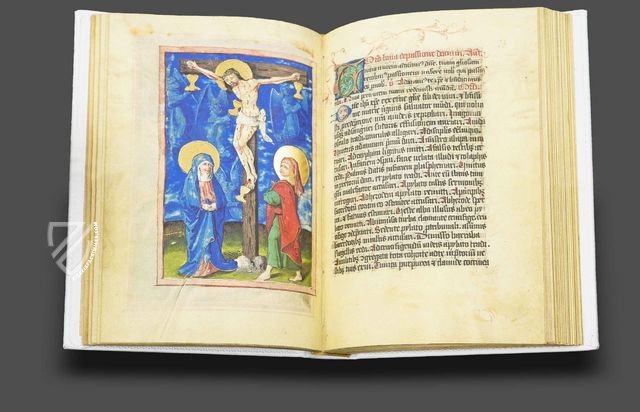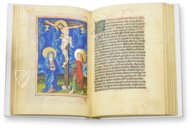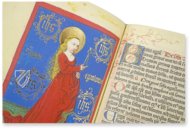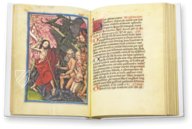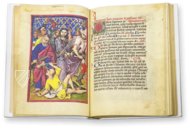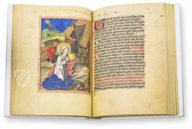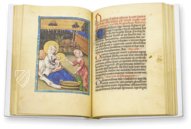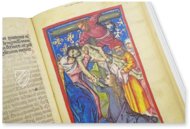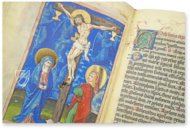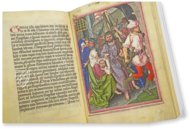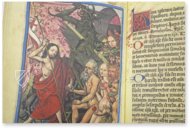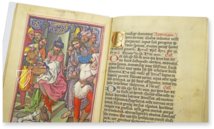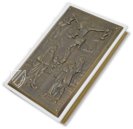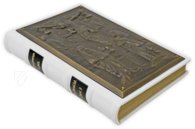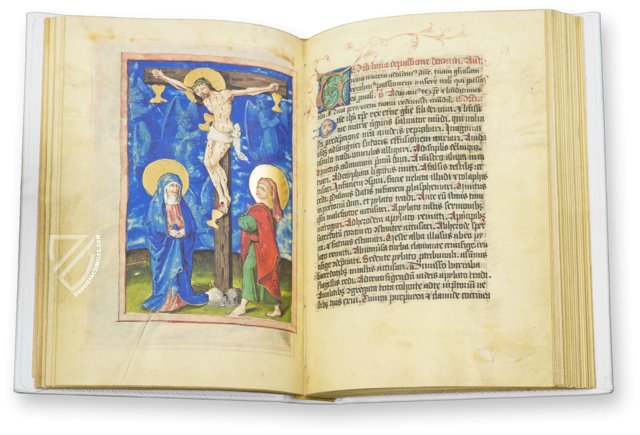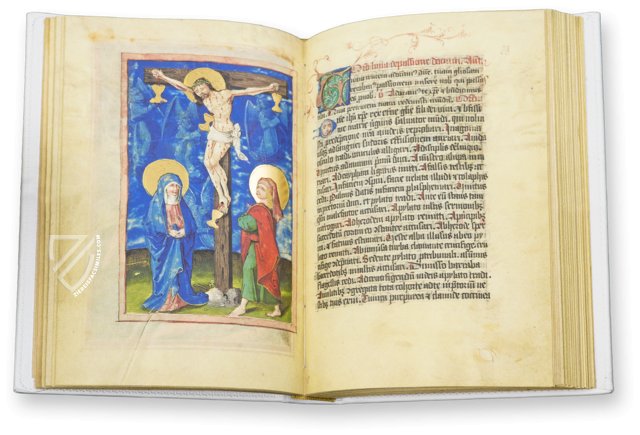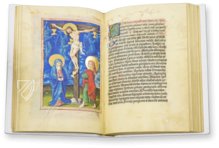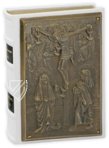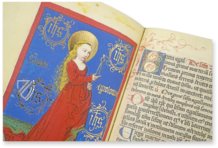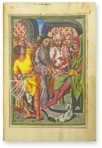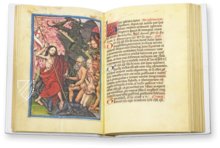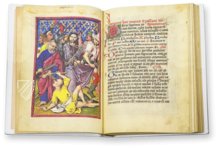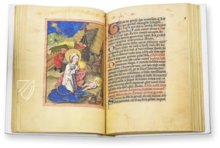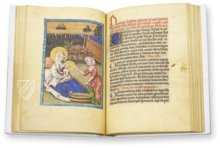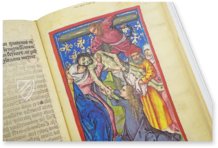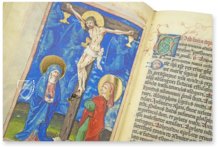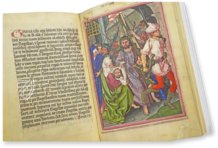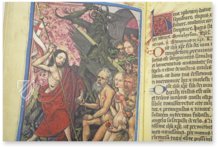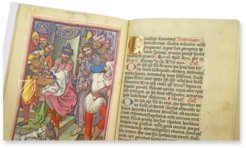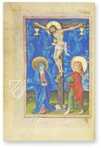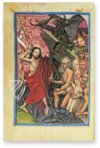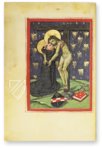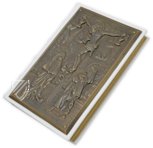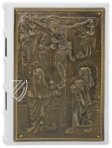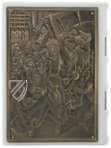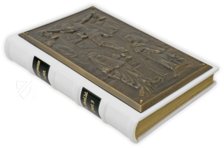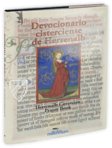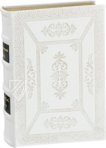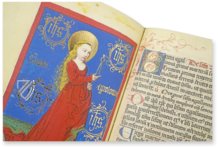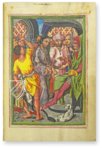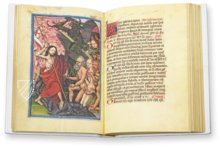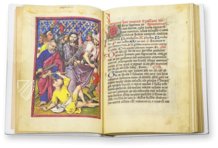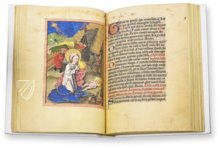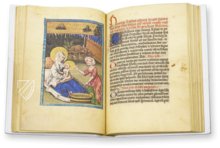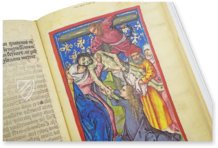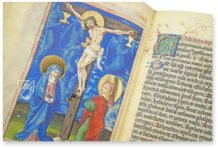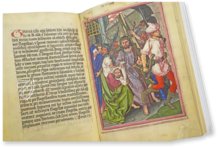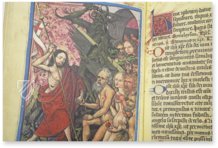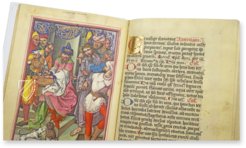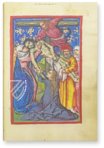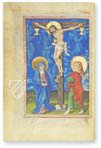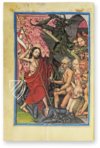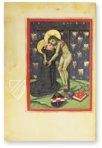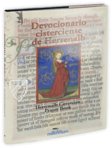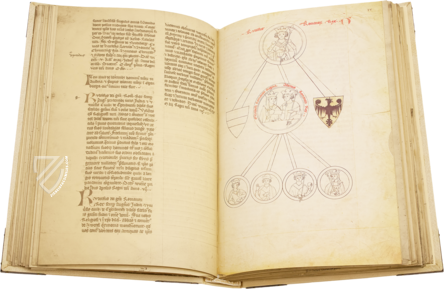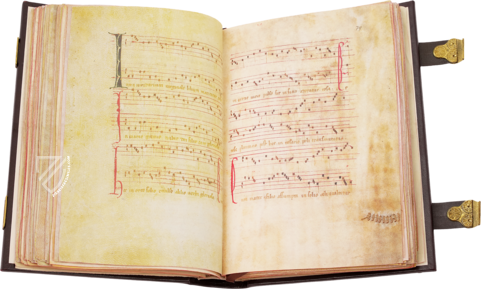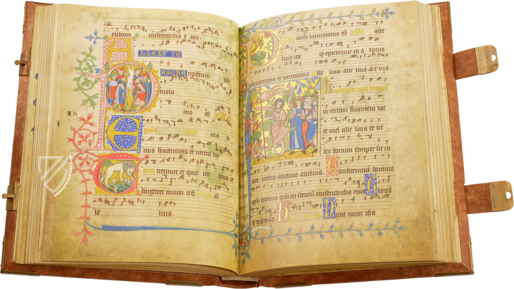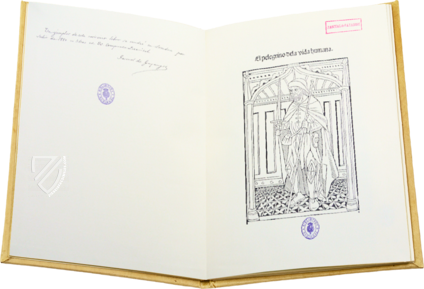Herrenalb Prayer Book
(3,000€ - 7,000€)
The so-called Herrenalb Prayer Book is a gem of late 15th century illumination. The manuscript is a wonderful attestation of its time, in which 30 splendid miniatures present scenes from the Passion. Nonetheless, there is something very special about these illustrations: they were modeled on copperplate etchings, which were made by various masters of this new printing technique! In this way, the piety that the patron from the Herrenalb Abbey had desired for such a work was wonderfully and profoundly conveyed. Johann Zürn from Neibsheim created a unique manuscript of his time with the Cistercian Devotional Book!
Cistercian Devotional Book
The so-called Herrenalb Prayer Book is a gem of late 15th century illumination. The manuscript is a wonderful attestation of its time, in which 30 splendid miniatures present scenes from the Passion. Nonetheless, there is something very special about these illustrations: they were modeled on copperplate etchings, which were made by various masters of this new printing technique! In this way, the piety that the patron from the Herrenalb Abbey had desired for such a work was wonderfully and profoundly conveyed. Johann Zürn from Neibsheim created a unique manuscript of his time with the Cistercian Devotional Book!
A Devout Commission
“This prayer book by Johann Zürn from Neibsheim, monk and cantor of our abbey at Herrenalb, was begun in the year 1482 and painstakingly completed in the year 1484 at the instigation and request of the Lay Brother Ludwig von Bruchsal, who occupied the office of procurator in Merklingen.” So begins the Latin text of Manuscript theo. Lat. quart. 9 of the State Library in Berlin, the so-called Herrenalb Prayer Book. Ludwig von Bruchsal commissioned the work in 1482, which wows not only because of the typical text, but also and especially because of its grandiose miniature pages.
An Illuminated Prayer Book from Herrenalb
The 206 parchment pages of the Cistercian Devotional Book contain a calendar, prayers to the Virgin Mary and saints, St. Bernhard of Clairvaux among others, and other typical texts for such a manuscript. The scribe and author of the prayer book was Johann Zürn from Nyposheim (present-day Neibsheim), cantor of the Cistercian Herrenalb Abbey in modern Baden-Württemberg, founded 1148. It is probable that this Johann Zürn was also responsible for the marvelous book adornment that makes the Cistercian Devotional Book so unique: 30 full-page miniatures with scenes of the Passion.
Copper Etchings as a Template
These impressive and magnificently-colored depictions do not represent the actual creations of the illuminator. Whoever the painter of these gorgeous compositions was, they relied upon templates in the form of masterful copperplate etchings. Therefore, among the examples were some copperplate etchings by the artist Martin Schongauer from the Upper Rhine, and also probably from a Strasbourg Master ES, a “Karlsruhe Master of 1446”, and the Upper Rhine Master WB. In this way, the innovative new technique of copperplate etching was “reverse engineered” into the established medium of illumination. Magnificent miniature pages were the result of this fruitful combination, belonging among some of the most beautiful that were produced in the 15th century!
Codicology
- Alternative Titles
- Das Herrenalb-Gebetbuch
Das Herrenalber Gebetbuch
Das Gebetbuch aus Herrenalb
Devocionario del Císter
Gebetbuch des Zisterzienserordens
Missel de l'Ordre de Cíteaux
Devozionario cisterciense
Devozionario cisterciense de Herrenalb
Cistercian Devotional Book - Size / Format
- 206 pages / 20.0 × 14.0 cm
- Origin
- Germany
- Date
- 1484
- Epochs
- Style
- Language
- Illustrations
- 30 full-page miniatures
- Artist / School
- Johannes Zurn of Nyposheim
Herrenalb Prayer Book
Christ before Pontius Pilate
Still bleeding from his beating and tied around the neck and wrists, Christ is shown being brought before Pontius Pilate, who is richly dressed in green, holding a scepter, and wearing a smug look on his face. The soldiers are armed with late medieval halberds and their turban-wearing captain reflects contemporary anxieties over the Turkish invasion of southeastern Europe. It is a crowded and boisterous scene filled with color and wonderfully highlighted with both gold and silver.
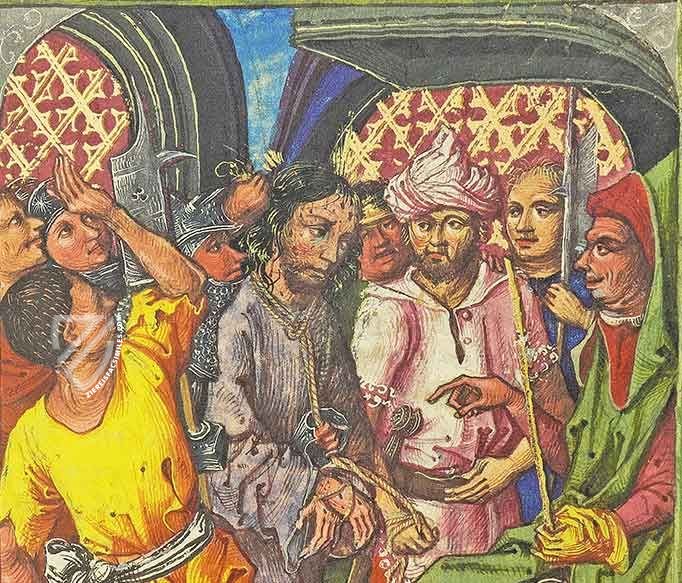
Herrenalb Prayer Book
St. Bernhard of Clairvaux
The Cistercian order was founded in the wake of reforms made to Benedictine monasticism, a movement that was led by St. Bernhard of Clairvaux, among others. As such, he is especially important for the members of that austere and diligent religious order, also known as the Bernardines. This scene adapts a typical Descent from the Cross but inserts Bernhard into the scene.
Bernhard literally makes Christ’s burden his own in this scene as he eases the Messiah down from the cross and takes his ashen body over his shoulder. He has laid his cardinal’s staff down on the verdant green ground next to his coat of arms and the manuscript at hand. The gold leaf stars and halos magnificently contrast the midnight blue sky and Bernhard’s black habit.
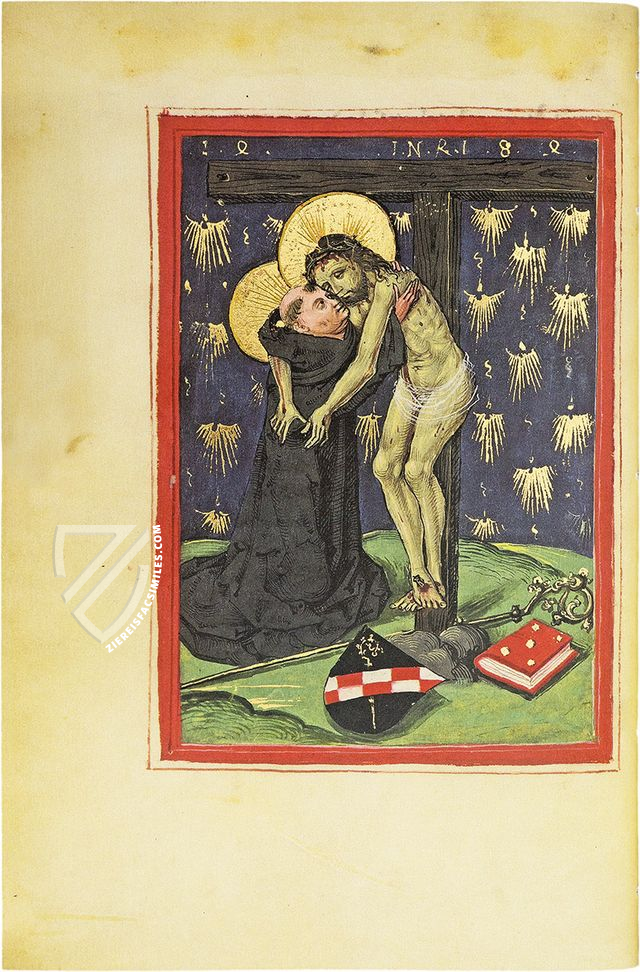
#1 Devocionario del Císter
Language: Spanish
(3,000€ - 7,000€)
#2 Devocionario Cisterciense de Herrenalb (Library Edition)
Language: Spanish
(1,000€ - 3,000€)
- Treatises / Secular Books
- Apocalypses / Beatus
- Astronomy / Astrology
- Bestiaries
- Bibles / Gospels
- Chronicles / History / Law
- Geography / Maps
- Saints' Lives
- Islam / Oriental
- Judaism / Hebrew
- Single Leaf Collections
- Leonardo da Vinci
- Literature / Poetry
- Liturgical Manuscripts
- Medicine / Botany / Alchemy
- Music
- Mythology / Prophecies
- Psalters
- Other Religious Books
- Games / Hunting
- Private Devotion Books
- Other Genres
- Afghanistan
- Armenia
- Austria
- Belgium
- Belize
- Bosnia and Herzegovina
- China
- Colombia
- Costa Rica
- Croatia
- Cyprus
- Czech Republic
- Denmark
- Egypt
- El Salvador
- Ethiopia
- France
- Germany
- Greece
- Guatemala
- Honduras
- Hungary
- India
- Iran
- Iraq
- Israel
- Italy
- Japan
- Jordan
- Kazakhstan
- Kyrgyzstan
- Lebanon
- Liechtenstein
- Luxembourg
- Mexico
- Morocco
- Netherlands
- Palestine
- Panama
- Peru
- Poland
- Portugal
- Romania
- Russia
- Serbia
- Spain
- Sri Lanka
- Sweden
- Switzerland
- Syria
- Tajikistan
- Turkey
- Turkmenistan
- Ukraine
- United Kingdom
- United States
- Uzbekistan
- Vatican City
- A. Oosthoek, van Holkema & Warendorf
- Aboca Museum
- Ajuntament de Valencia
- Akademie Verlag
- Akademische Druck- u. Verlagsanstalt (ADEVA)
- Aldo Ausilio Editore - Bottega d’Erasmo
- Alecto Historical Editions
- Alkuin Verlag
- Almqvist & Wiksell
- Amilcare Pizzi
- Andreas & Andreas Verlagsbuchhandlung
- Archa 90
- Archiv Verlag
- Archivi Edizioni
- Arnold Verlag
- ARS
- Ars Magna
- ArtCodex
- AyN Ediciones
- Azimuth Editions
- Badenia Verlag
- Bärenreiter-Verlag
- Belser Verlag
- Belser Verlag / WK Wertkontor
- Benziger Verlag
- Bernardinum Wydawnictwo
- BiblioGemma
- Biblioteca Apostolica Vaticana (Vaticanstadt, Vaticanstadt)
- Bibliotheca Palatina Faksimile Verlag
- Bibliotheca Rara
- Boydell & Brewer
- Bramante Edizioni
- Bredius Genootschap
- Brepols Publishers
- British Library
- C. Weckesser
- Caixa Catalunya
- Canesi
- CAPSA, Ars Scriptoria
- Caratzas Brothers, Publishers
- Carus Verlag
- Casamassima Libri
- Centrum Cartographie Verlag GmbH
- Chavane Verlag
- Christian Brandstätter Verlag
- Circulo Cientifico
- Club Bibliófilo Versol
- Club du Livre
- CM Editores
- Collegium Graphicum
- Collezione Apocrifa Da Vinci
- Comissão Nacional para as Comemorações dos Descobrimentos Portugueses
- Coron Verlag
- Corvina
- CTHS
- D. S. Brewer
- Damon
- De Agostini/UTET
- De Nederlandsche Boekhandel
- De Schutter
- Deuschle & Stemmle
- Deutscher Verlag für Kunstwissenschaft
- DIAMM
- Droz
- E. Schreiber Graphische Kunstanstalten
- Ediciones Boreal
- Ediciones Grial
- Ediclube
- Edições Inapa
- Edilan
- Editalia
- Edition Deuschle
- Edition Georg Popp
- Edition Leipzig
- Edition Libri Illustri
- Editiones Reales Sitios S. L.
- Éditions de l'Oiseau Lyre
- Editions Medicina Rara
- Editorial Casariego
- Editorial Mintzoa
- Editrice Antenore
- Editrice Velar
- Edizioni Edison
- Egeria, S.L.
- Eikon Editores
- Electa
- Emery Walker Limited
- Enciclopèdia Catalana
- Eos-Verlag
- Ephesus Publishing
- Ernst Battenberg
- Eugrammia Press
- Extraordinary Editions
- Fackelverlag
- Facsimila Art & Edition
- Facsimile Editions Ltd.
- Facsimilia Art & Edition Ebert KG
- Faksimile Verlag
- Feuermann Verlag
- Folger Shakespeare Library
- Franco Cosimo Panini Editore
- Friedrich Wittig Verlag
- Fundación Hullera Vasco-Leonesa
- G. Braziller
- Gabriele Mazzotta Editore
- Gebr. Mann Verlag
- Gesellschaft für graphische Industrie
- Getty Research Institute
- Giovanni Domenico de Rossi
- Giunti Editore
- Graffiti
- Grafica European Center of Fine Arts
- Guido Pressler
- Guillermo Blazquez
- Gustav Kiepenheuer
- H. N. Abrams
- Harrassowitz
- Harvard University Press
- Helikon
- Hendrickson Publishers
- Henning Oppermann
- Herder Verlag
- Hes & De Graaf Publishers
- Hoepli
- Holbein-Verlag
- Houghton Library
- Hugo Schmidt Verlag
- Idion Verlag
- Il Bulino, edizioni d'arte
- ILte
- Imago
- Insel Verlag
- Insel-Verlag Anton Kippenberger
- Instituto de Estudios Altoaragoneses
- Instituto Nacional de Antropología e Historia
- Introligatornia Budnik Jerzy
- Istituto dell'Enciclopedia Italiana - Treccani
- Istituto Ellenico di Studi Bizantini e Postbizantini
- Istituto Geografico De Agostini
- Istituto Poligrafico e Zecca dello Stato
- Italarte Art Establishments
- Jan Thorbecke Verlag
- Johnson Reprint Corporation
- Josef Stocker
- Josef Stocker-Schmid
- Jugoslavija
- Karl W. Hiersemann
- Kasper Straube
- Kaydeda Ediciones
- Kindler Verlag / Coron Verlag
- Kodansha International Ltd.
- Konrad Kölbl Verlag
- Kurt Wolff Verlag
- La Liberia dello Stato
- La Linea Editrice
- La Meta Editore
- Lambert Schneider
- Landeskreditbank Baden-Württemberg
- Leo S. Olschki
- Les Incunables
- Liber Artis
- Library of Congress
- Libreria Musicale Italiana
- Lichtdruck
- Lito Immagine Editore
- Lumen Artis
- Lund Humphries
- M. Moleiro Editor
- Maison des Sciences de l'homme et de la société de Poitiers
- Manuscriptum
- Martinus Nijhoff
- Maruzen-Yushodo Co. Ltd.
- MASA
- Massada Publishers
- McGraw-Hill
- Metropolitan Museum of Art
- Militos
- Millennium Liber
- Müller & Schindler
- Nahar - Stavit
- Nahar and Steimatzky
- National Library of Wales
- Neri Pozza
- Nova Charta
- Oceanum Verlag
- Odeon
- Orbis Mediaevalis
- Orbis Pictus
- Österreichische Staatsdruckerei
- Oxford University Press
- Pageant Books
- Parzellers Buchverlag
- Patrimonio Ediciones
- Pattloch Verlag
- PIAF
- Pieper Verlag
- Plon-Nourrit et cie
- Poligrafiche Bolis
- Presses Universitaires de Strasbourg
- Prestel Verlag
- Princeton University Press
- Prisma Verlag
- Priuli & Verlucca, editori
- Pro Sport Verlag
- Propyläen Verlag
- Pytheas Books
- Quaternio Verlag Luzern
- Reales Sitios
- Recht-Verlag
- Reichert Verlag
- Reichsdruckerei
- Reprint Verlag
- Riehn & Reusch
- Roberto Vattori Editore
- Rosenkilde and Bagger
- Roxburghe Club
- Salerno Editrice
- Saltellus Press
- Sandoz
- Sarajevo Svjetlost
- Schöck ArtPrint Kft.
- Schulsinger Brothers
- Scolar Press
- Scrinium
- Scripta Maneant
- Scriptorium
- Shazar
- Siloé, arte y bibliofilia
- SISMEL - Edizioni del Galluzzo
- Sociedad Mexicana de Antropología
- Société des Bibliophiles & Iconophiles de Belgique
- Soncin Publishing
- Sorli Ediciones
- Stainer and Bell
- Studer
- Styria Verlag
- Sumptibus Pragopress
- Szegedi Tudomànyegyetem
- Taberna Libraria
- Tarshish Books
- Taschen
- Tempus Libri
- Testimonio Compañía Editorial
- Thames and Hudson
- The Clear Vue Publishing Partnership Limited
- The Facsimile Codex
- The Folio Society
- The Marquess of Normanby
- The Richard III and Yorkist History Trust
- Tip.Le.Co
- TouchArt
- TREC Publishing House
- TRI Publishing Co.
- Trident Editore
- Tuliba Collection
- Typis Regiae Officinae Polygraphicae
- Union Verlag Berlin
- Universidad de Granada
- University of California Press
- University of Chicago Press
- Urs Graf
- Vallecchi
- Van Wijnen
- VCH, Acta Humaniora
- VDI Verlag
- VEB Deutscher Verlag für Musik
- Verlag Anton Pustet / Andreas Verlag
- Verlag Bibliophile Drucke Josef Stocker
- Verlag der Münchner Drucke
- Verlag für Regionalgeschichte
- Verlag Styria
- Vicent Garcia Editores
- W. Turnowski Ltd.
- W. Turnowsky
- Waanders Printers
- Wiener Mechitharisten-Congregation (Wien, Österreich)
- Wissenschaftliche Buchgesellschaft
- Wissenschaftliche Verlagsgesellschaft
- Wydawnictwo Dolnoslaskie
- Xuntanza Editorial
- Zakład Narodowy
- Zollikofer AG

